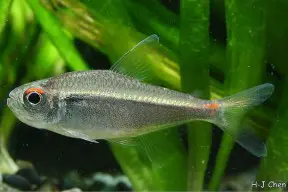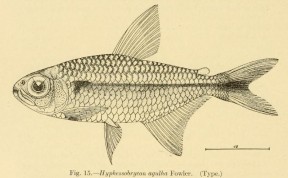Hyphessobrycon agulha
Etymology
Hyphessobrycon: from the Ancient Greek υπελάσσων (hyphesson), meaning ‘of lesser stature’, used as a prefix in this case, plus the generic name Brycon.
agulha: the native name for the fish.
Classification
Order: Characiformes Family: Characidae
Distribution
Known with certainty only from the rio Madeira system, the largest tributary within the Amazon basin of which the majority lies in Amazonas state, northwestern Brazil with parts in Rondônia state plus Peru and Bolivia.
Type locality is given as ‘Madeira River, about 200 miles east of W. Long. 62°20′, Brazil’, and it has also been collected from tributaries in the vicinity of Porto Velho.
Records also exist from the upper and lower Amazon regions in Peru and the ri0 Tapajós drainage, respectively, but these appear to require confirmation.
Maximum Standard Length
The largest officially-recorded specimen measured 42 mm.
Aquarium SizeTop ↑
An aquarium with base dimensions of 80 ∗ 30 cm or equivalent should be the smallest considered.
Maintenance
Perhaps looks best in an arrangement comprising a sandy substrate plus some driftwood roots and branches although it should also thrive in a planted set-up.
The addition of dried leaf litter would further emphasise the natural feel and as well as offering additional cover for the fish brings with it the growth of microbe colonies as decomposition occurs.
The latter are useful since they provide an additional food source for both adults and fry while the humic substances released by decaying leaves are also considered beneficial.
Water Conditions
Temperature: 20 – 28 °C
pH: 5.5 – 7.5
Hardness: 18 – 215 ppm
Diet
Likely to be omnivorous feeding on small invertebrates, crustacea, filamentous algae, fallen fruit and suchlike in nature.
In aquaria it may survive on a diet of dried foods but like most fishes does best when offered a varied menu which in this case should also contain live and frozen chironomid larvae (bloodworm), mosquito larvae, Daphnia, Moina, etc.
Behaviour and CompatibilityTop ↑
Very peaceful making it an ideal resident of the well-researched community aquarium.
It is perhaps best-maintained alongside similarly-sized characids, gasteropelecids, lebiasinids, smaller callichthyid or loricariid catfishes and non-predatory, small-to-medium-sized cichlids.
Try to buy a mixed-sex group of at least 8-10 specimens, include other schooling fishes to provide security, and you’ll be rewarded with a more natural-looking spectacle.
Sexual Dimorphism
Sexually mature females are noticeably deeper-bodied and grow slightly larger than males.
Reproduction
Unreported.
NotesTop ↑
H. aghula is relatively rare in the aquarium hobby but is occasionally traded as ‘red-tailed flag tetra’.
The most recent diagnosis appears to be that of Géry (1977), in which it was separated from similar species by the following combination of characters: head length fits 3.5-4.0 times in SL; dorsal-fin insertion anterior to midbody; maxilla reaching pupil; usually 9-10 predorsal scales; 33-35 longitudinal scales; 19-21 branched anal-fin rays. The dark lateral body stripe also extends onto the median caudal-fin rays as per Fowler’s original description.
It lends its name to the H. aghula group of closely-related species within the genus as proposed by Géry (1977) of which all members possess a dark lower half of the body, especially above the anal-fin, and usually a horizontally elongate humeral spot, more or less united with the asymmetrical, broad band. Other species in this group include H. loretoensis, H. peruvianus, H. metae, and H. herbertaxelrodi, although some authors have included one or more of these, including H. agulha, in the H. heterohabdus group.
Lima et al. 2014 noted similarities between the H. aghula group and their revised H. heterorhabdus group which comprises Hyphessobrycon heterorhabdus, H. amapaensis, and H. eschwartzae. This trio all possess: a well-defined, elongate humeral blotch which is continuous with a dark, well-defined midlateral stripe that becomes blurred towards the caudal peduncle; a longitudinal red stripe extending along the body above the midlateral line; upper half of the eye red.
This pattern is different to that presented by several members of Géry’s original H. heterorhabdus group, such as H. vilmae, H. cachimbensis, and H. stegemanni, which possess a continuous, solid dark lateral stripe on the body and no obvious humeral blotch.
Hyphessobrycon was raised by Durbin in Eigenmann (1908) as a subgenus of Hemigrammus, differing from the latter by the absence of scales on the caudal-fin.
The grouping was revised by Eigenmann (1918, 1921) while Géry (1977) created artificial groups of species based on colour pattern, and these definitions are still widely used today, e.g., the H. agulha group, the H. heterohabdus group, etc. These cannot be considered to represent monophyletic assemblages, however, and their concepts continue to be redefined.
Weitzman & Palmer (1997) hypothesised the existence of a monophyletic assemblage within the genus based on colour pattern and male fin morphology that they termed the ‘rosy tetra clade’, with one of the characters supporting its monophyly being presence of a prominent dark marking on the dorsal-fin. This assemblage, plus other morphologically similar species, is considered to represent Hyphessobrycon sensu stricto by some authors, with the remaining species included in a much-expanded H. heterohabdus group.
Others have proposed conflicting, typically more restricted, views of both the genus and/or its constituent species groups, and significant confusion remains. What is clear is that, as currently recognised, Hyphessobrycon is a polyphyletic lineage containing several genera.
The process of splitting it up has already started, and Malabarba et al. (2012) revalidated the genus Ectrepopterus Fowler, previously considered a synonym of Hyphessobrycon. They also analysed its relationships within the Characidae in the context of Mirande’s (2010) previous work, but included the type species, H. compressus, for the first time in such a study. The results demonstrated that H. compressus is more closely-related to ‘rosy tetra’ representatives such as H. eques, H. pulchripinnis, and H. socolofi than other members of the genus including H. anisitsi, H. bifasciatus, H. elachys, H. herbertaxelrodi, and H. luetkeni.
References
- Fowler, H. W., 1913 - Proceedings of the Academy of Natural Sciences of Philadelphia v. 65: 517-579
Fishes from the Madeira River, Brazil. - Calcagnotto, D., S. A. Schaefer, and R. DeSalle, 2005 - Molecular Phylogenetics and Evolution 36(1): 135-153
Relationships among characiform fishes inferred from analysis of nuclear and mitochondrial gene sequences. - Géry, J., 1977 - T. F. H. Publications, Inc.: 1-672
Characoids of the world. - Lima, F. C. T., D. P. Coutinho and W. B. Wosiacki , 2014 - Zootaxa 3872(2): 167-179
A new Hyphessobrycon (Ostariophysi: Characiformes: Characidae) from the middle Amazon basin, Brazil. - Malabarba, L. R., V. A. Bertaco, F. R. Carvalho & T. O. Litz., 2012 - Zootaxa 3204: 47-60
Revalidation of the genus Ectrepopterus Fowler (Teleostei: Characiformes), with the redescription of its type species, E. uruguayensis. - Mirande, J. M., 2010 - Neotropical Ichthyology 8(3): 385-568
Phylogeny of the family Characidae (Teleostei: Characiformes): from characters to taxonomy. - Oliveira, C. A., G. S. Avellino, K. T. Abe, T. C. Mariguela, R. C. Benine, G. Orti, R. P. Vari, and R. M. Corrêa e Castro, 2011 - BMC Evolutionary Biology 11(1): 275-300
Phylogenetic relationships within the speciose family Characidae (Teleostei: Ostariophysi: Characiformes) based on multilocus analysis and extensive ingroup sampling. - Ortega, H. and R. P. Vari , 1986 - Smithsonian Contributions to Zoology No. 437: iii + 1-25
Annotated checklist of the freshwater fishes of Peru. - Reis, R. E., S. O. Kullander and C. J. Ferraris, Jr. (eds), 2003 - EDIPUCRS, Porto Alegre: i-xi + 1-729
Check list of the freshwater fishes of South and Central America. CLOFFSCA. - Weitzman, S. H. and L. Palmer, 1997 - Ichthyological Exploration of Freshwaters 7(3): 209-242
A new species of Hyphessobrycon (Teleostei: Characidae) from the Neblina region of Venezuela and Brazil, with comments on the putative `rosy tetra clade'. - Zarske, A., 2014 - Vertebrate Zoology 64(2): 139-167
Zur Systematik einiger Blutsalmler oder "Rosy Tetras" (Teleostei: Ostariophysi: Characidae).





November 28th, 2019 at 12:47 pm
The distribution information on this site does not corespond with the information available on https://www.gbif.org/. On GBIF the distrubution is said to include large parts of south america while this site claims the distribution is known “only from the rio Madeira system”. Here is a link: https://www.gbif.org/species/2354657